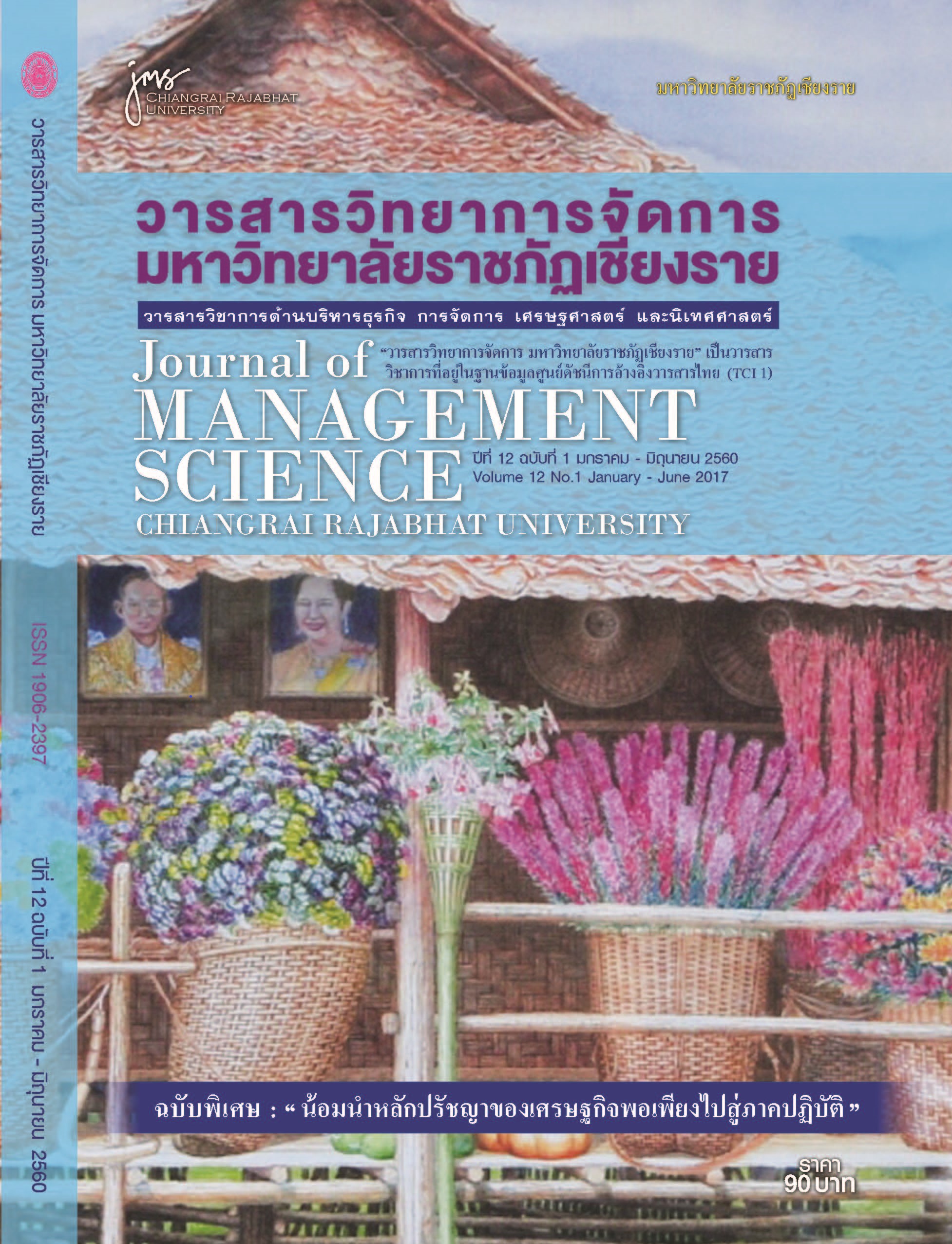Participation Management Model Based on the Sufficiency Economy Philosophy of the Agriculturist Group Planting the Chrysanthemum Flowers of the Sa-Ngo Royal Project Development Center in Chiang Rai Province
Main Article Content
Abstract
The purposes of this research were to1) study and develop the agriculturists planting the Chrysanthemum Tea of Sa-Ngo Royal Project Development Center, Chiang Rai by using participatory action research based on the philosophy of sufficiency economy 2) investigate the model of group management, production and business management based on the philosophy of sufficiency economy of the agriculturists planting the Chrysanthemum Tea of Sa-Ngo Royal Project Development Center, Chiang Rai. This research was a participatory action research (PAR). Population was 31 agriculturists planting the Chrysanthemum Tea of Sa-Ngo Royal Project Development Center, Chiang Rai. Research instruments were observation and interview and analyze qualitative data by content analysis.
The study was revealed that the group development started from 1) training on the knowledge of the philosophy of sufficiency economy 2) following-up and solve problems after the training and 3) evaluation and development together. There was three operation models of the group such as the group management model, the production model, and the business management model.
Article Details
Views and opinions expressed in the journal do not necessarily reflect those of the editors.
References
ธวัชชัย ไพใหล, นันตพร นิลจินดา, ประสิทธิ์ คะเลรัมย์, รัฐพล ฤทธิธรรม, วิชาญ ฤทธิธรรม, อำนาจ สุนาพรม, และกำชัย เนาว์ศรีสอน. (2551). การพัฒนาศักยภาพกลุ่มเกษตรกรตามปรัชญาเศรษฐกิจพอเพียง: กรณีศึกษา หมู่บ้านรอบหนองหาร จังหวัดสกลนคร. สำนักงานคณะกรรมการการวิจัยแห่งชาติ.
ประเวทย์ ใจฝั้น และสุกัญญา ใจฝั้น. (2556). โครงการวิจัยการศึกษารูปแบบการร่วมกลุ่มและการเชื่อมโยงสู่ตลาดอย่างยั่งยืนภายใต้โครงสร้างและพัฒนาเกษตรกรรุ่นใหม่ในพื้นที่ศูนย์นิคมเศรษฐกิจพอเพียง อำเภอวังน้ำเขียว จังหวัดนครราชสีมา. วิทยาลัยเกษตรและเทคโนโลยีนครราชสีมา.
พิพัฒน์ ยอดพฤติการ. (2550). เศรษฐกิจพอเพียง หมายถึง อะไร. พิมพ์ครั้งที่ 2. กรุงเทพมหานคร: สถาบันไทยพัฒน์.
มูลนิธิโครงการหลวง. (2560) สืบค้นจาก https://www.thairoyalprojecttour.com.
สมเกียรติ ศรลัมพ์. (2551). เศรษฐกิจพอเพียงกับการประยุกต์ใช้ในระดับต่างๆ. กรุงเทพมหานคร: ประดิพัทธ์.
สุภาพรรณ พาบุ, ธงชัย พาบุ, สาคร แสงสุวอ, เสงี่ยม กลอนไธสง, โชติกา ฉิมงามเสริฐ และโกเมท จันทรสมโภชน์. (2554). การดำเนินการที่ประสบผลสำเร็จตามแนวทางเศรษฐกิจพอเพียงของกลุ่มผู้ผลิตข้าว หอมมะลิอินทรีย์ในจังหวัดสุรินทร์. เทคโนโลยีราชมงคลอีสาน วิทยาเขตสุรินทร์.
สุเมธ ตันติเวชกุล. (2550). Sufficiency Economy เศรษฐกิจพอเพียง. ไพเราะ เลิศวิราม (บรรณาธิการ).กรุงเทพมหานคร: ไทยเดย์ ด็อท คอม.

